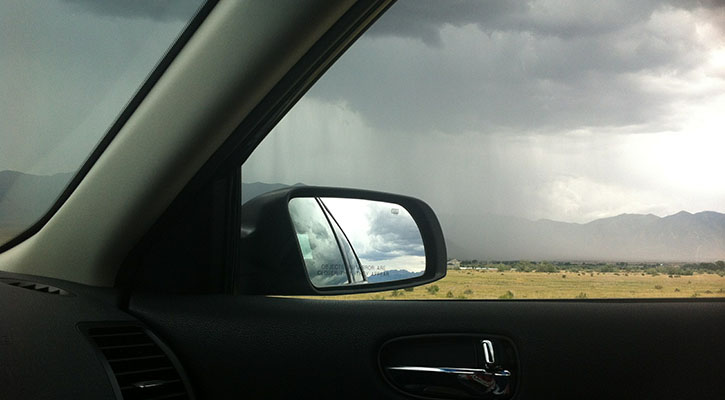In this article, we will discuss six quick tips for making sure you and your vehicle are ready for the storm.
1) Remove Hazards from Your Parking Place
Before the storm strikes, it is vital to remove potential hazards near your parking spot. Whether you park in a driveway or parking lot, potential damaging debris includes:
- Small or dead trees
- Overhead limbs, especially if they are dead or loose
- Trash cans and recycling bins
- Non-anchored yard decorations
- Fencing
- Loose or damaged gutters
2) Know Whether Your Vehicle is in a Flood Prone Area
Many vehicles are damaged during heavy rain events in our area, due to rapidly rising waters in parking lots and near fast-flowing streams. Poor drainage in yards, parking lots, and even neighborhood streets will contribute to quick rises in water levels. Before the rain begins, make sure you are aware of potential flash flooding in parking lots, and whether your home or property is susceptible to rising water.
3) Pack Your Emergency Preparedness Kit
If you need to travel during the storm, make sure you are prepared. Pack any supplies you might need if you are delayed due to flood waters, heavy traffic, or high winds. Your emergency preparedness kit includes:
- First aid
- Bottled water
- Food
- Flashlight
- Batteries
- Cell phone charger or extra battery
- Spare tire and tire changing tools
- Light jacket or blanket

4) Perform Proper and Necessary Maintenance
It is always wise to make sure any maintenance due has been performed before the storm begins. Necessary maintenance includes:
- Oil change
- Tire rotation and balance
- Proper wheel alignment
- Transmission and brake fluid checks
- Transmission service
- Fuel injection service
- Replacing worn brake pads and rotors
- Any other necessary repairs
5) Check Your Tires
Before you travel during a weather event, make sure you check your tires for these things:
- Plenty of tread depth
- No cracks, cuts, or dry rot
- Proper air pressure
- Recent rotation and balance
If your tires are in poor condition, have them replaced before driving in heavy rain.
6) Remember Rain and Poor Weather Driving Rules
Make sure you keep the rules of driving in wet weather:
- Reduce your speed
- Increase your following distance
- Avoid sudden movements
- If your wipers are on, your lights should be on
- Steer into a skid
- Turn around, don’t drown
For vehicle maintenance, oil changes, tire rotations, and other mechanical needs, visit RetroLube. Located in Goldsboro, NC, we work on any make and model of vehicle, well-aged or brand new.